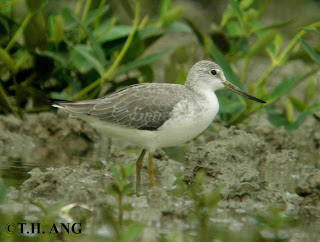 This is a very rare opportunity to have an intimate look at the Nordmann's Greenshank held in hand. On 05 April 2005, Adrian Boyle, a researcher from Australia, had caught 2 out of 3 Nordmann's Greenshanks present at Chongming Dao Nature Reserve, near Shanghai, China.
This is a very rare opportunity to have an intimate look at the Nordmann's Greenshank held in hand. On 05 April 2005, Adrian Boyle, a researcher from Australia, had caught 2 out of 3 Nordmann's Greenshanks present at Chongming Dao Nature Reserve, near Shanghai, China. The birds were on their spring northwards trip to the breeding ground. Photos have shown that the bird has assumed partial breeding plumage. The heavily spotted breast and head as well as dark upper parts with white notches are the characteristics of breeding plumage.
If you have any further comments/inputs on its plumage, feel free to write to myself (copsychus at yahoo dot com) or Adrian (adrianboyle at westnet dot com dot au)

Nordmann's Greenshank has pure white underwing and axillaries, whereas Common Greenshank has finely barred underwing and axillaries.
^
^
^
^
^
 This is the legendary web that many would love to see it in the field. Nordmann's Greenshank is quite unique among Tringa sandpipers in having partial toe-webbing especially the outer toe (left photo).
This is the legendary web that many would love to see it in the field. Nordmann's Greenshank is quite unique among Tringa sandpipers in having partial toe-webbing especially the outer toe (left photo). ^
^
In contrast with the Common Greenshank (right photo, courtesy of Adrian Boyle and al) the web is significantly reduced in the outer toe(right) and almost webless in the inner toe (left).
^
^
^
^
^
^
Special acknowledgements: Many thanks to Adrian Bolye who has kindly permitted the use of the photos.









